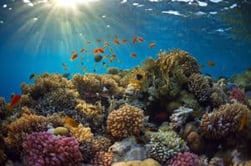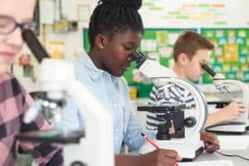Organisms to Ecosystems Inquiry Lab
Middle School Inquiry Lab on Organisms to Ecosystems
In this lab students will use the levels of organization as they make plans for a freshwater aquarium. Students will choose an organism, decide how large a population of that species they want, choose compatible community members, and add abiotic factors to the ecosystem.
Each inquiry lab will contain an essential question that will drive the lesson and make students think. For this lesson, the essential question is:
- How do scientists organize all the elements of an ecosystem?
BACKGROUND INFORMATION AND MATERIALS LIST:
Students will begin the lab by reading the essential question and background information. This can be done individually, as lab groups, or as a whole class. If you consider lab groups, you also might include some type of whole class formative checks before digging into the lab.

Materials List:
- ecosystem resources pages
- colored pencils
- success test page (kept by teacher until needed)
- paper to draw design (if time allows)
PROCEDURE:
This lab will end up having students “test” the success of their ecosystem and compare their results with other groups.
Students get to design an imaginary aquarium environment while taking into consideration everything that makes a successful ecosystem. Students are tasked with deciding on which organisms they want to start off with. Each organism has their own profile which also include its maximum size.
Once students have decided on their organism, students then decide how many they need for their population. From there, students start thinking about what kind of community fits best with their organism. This level will have students decide from microscopic organisms to plants to other fish they want to include. Finally, students will have to analyze what types of abiotic factors are going to play a vital role in their aquarium ecosystem’s survival.
CHECK FOR UNDERSTANDING:
At this point in the lab, students will be checked for understanding by answering questions about their findings. Here are a few that come with the lab:
- What size population is right for your fish?
- How can you control microscopic populations?
CONCLUSION
Students will go back to the essential question and write a CER (Claim, Evidence, Reasoning) to conclude the lab. Once completed, students will reflect back on their learning by answering the following questions:
- Compare your results with another group. Why did your ecosystems survive or fail?
- What could you have changed in your ecosystem to make it more successful?
MODIFIED AND INDEPENDENT INQUIRY VERSIONS
All of the Kesler Science inquiry labs come with three different modification levels. Each lab is differentiated using the icons below.
STANDARDS ALIGNMENT
TEKS: 6.12F – Diagram the levels of organization within an ecosystem, including organism, population, community, and ecosystem.

Download Over $100 in FREE Resources
For Middle School Science
Simply create a login below and gain immediate access to a selection of our Kesler Science product line worth $100 - for FREE. There's a full version of every product type! You'll also join tens of thousands of middle school science teachers who receive timely tips and strategies straight to their inbox.





